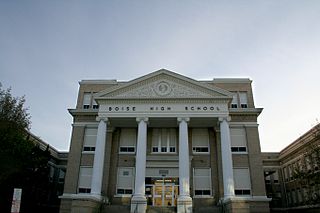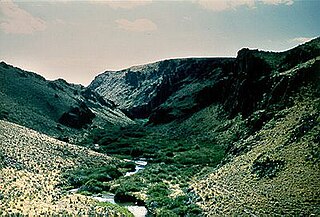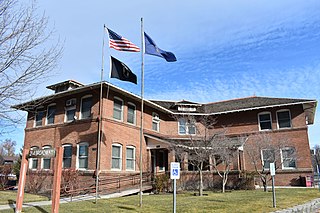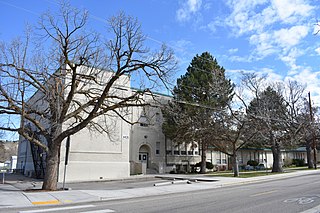
The Snake River is a major river of the greater Pacific Northwest region in the United States. At 1,078 miles (1,735 km) long, it is the largest tributary of the Columbia River, in turn the largest North American river that empties into the Pacific Ocean. The Snake River rises in western Wyoming, then flows through the Snake River Plain of southern Idaho, the rugged Hells Canyon on the Oregon–Idaho border and the rolling Palouse Hills of Washington, emptying into the Columbia River at the Tri-Cities, Washington.

Twin Falls is the county seat and largest city of Twin Falls County, Idaho, United States. The city had a population of 44,125 as of the 2010 census.

This is a directory of properties and districts included among the National Register of Historic Places listings in Idaho. There are approximately 1,000 sites in Idaho listed on the National Register. Each of the state's 44 counties has at least one listing on the National Register.

Boise High School is a public secondary school in Boise, Idaho, one of five traditional high schools within the city limits, four of which are in the Boise School District. A three-year comprehensive high school, Boise High is located on the outlying edge of the city's downtown business core. The enrollment for the 2014–15 school year was approximately 1,481.

Milner Dam is a rockfill dam near Burley in south central Idaho. It impounds the Snake River in a reservoir named Milner Lake. The dam spans the river across two islands, with three embankments.

Wechsler School is a historic school in Meridian, Mississippi erected in 1894. The school was the first brick public school building in Mississippi built with public funds for African-American children. It originally served primary through eighth grades but was later expanded to include high school as well. The school was named in honor of Rabbi Judah Wechsler of Congregation Beth Israel, who had led and inspired Meridian public to approve a bond issue to raise money for construction of the school. The school was listed on the National Register of Historic Places in 1991 and designated a Mississippi Landmark in 1993.

Salmon Falls Creek is a tributary of the Snake River, flowing from northern Nevada into Idaho in the United States. Formed in high mountains at the northern edge of the Great Basin, Salmon Falls Creek flows northwards 121 miles (195 km), draining an arid and mountainous basin of 2,103 square miles (5,450 km2). The Salmon Falls Creek valley served as a trade route between the Native American groups of the Snake River Plain and Great Basin. Today, most of its water is used for irrigation.

The Minidoka Project is a series of public works by the U.S. Bureau of Reclamation to control the flow of the Snake River in Wyoming and Idaho, supplying irrigation water to farmlands in Idaho. One of the oldest Bureau of Reclamation projects in the United States, the project involves a series of dams and canals intended to store, regulate and distribute the waters of the Snake, with electric power generation as a byproduct. The water irrigates more than a million acres (4,000 km²) of otherwise arid land, producing much of Idaho's potato crop. Other crops include alfalfa, fruit and sugar beets. The primary irrigation district lies between Ashton in eastern Idaho and Bliss in the southwestern corner of the state. Five main reservoirs collect water, distributing it through 1,600 miles (2,600 km) of canals and 4,000 miles (6,400 km) of lateral distribution ditches.

James Dobson Elementary School is historic elementary school located in the Manayunk neighborhood of Philadelphia, Pennsylvania. It is part of the School District of Philadelphia. The building was designed by Irwin T. Catharine and built in 1929–1930. It is a three-story, five bay, brick building on a raised basement in the Late Gothic Revival-style. It features an entrance pavilion with stone-trimmed arched opening, and brick piers with stone trim.

D. Newlin Fell School is a public elementary school located in the East Oregon neighborhood of South Philadelphia. It is part of the School District of Philadelphia, and shares a site with the George C. Thomas Junior High School. It was named in honor of D. Newlin Fell, who served as a Justice of the Pennsylvania Supreme Court from 1894 to 1910 and Chief Justice until 1915.

George W. Childs Elementary School is a K-8 school located in the Point Breeze neighborhood of Philadelphia, Pennsylvania. It is part of the School District of Philadelphia, and the historic building it occupies previously housed the Jeremiah Nichols School and Norris S. Barratt Junior High School.

Salmon Falls Dam is a dam constructed across Salmon Falls Creek in Twin Falls County, Idaho, in the United States. Located about 28 miles (45 km) southwest of Twin Falls, the masonry arch-gravity dam is 217 feet (66 m) high and 450 feet (140 m) long, impounding up to 230,650 acre feet (0.28450 km3) of water in Salmon Falls Creek Reservoir. When full, the reservoir extends for 17 miles (27 km) upstream, encompassing 3,400 acres (1,400 ha). The dam and reservoir control runoff from a drainage basin of 1,610 sq mi (4,200 km2).

Jefferson Elementary School is a historic elementary school building located in Washington Township, Daviess County, Indiana. It was built in 1924, and is a one-story, "I"-shaped, red brick building on a high raised basement with Colonial Revival and Bungalow / American Craftsman style design elements. The building has limestone detailing and a hipped roof topped by a cupola. It has a two-story gymnasium wing. The school closed in 1976.

The Reclamation Service Boise Project Office in Boise, Idaho, is a 2-story, L-shape Bungalow with entry at a porch on the inside corner. Finished in 1912, the building is constructed of brick with corbels separating basement, first, and second floors, and it includes segmented arch window openings. The low pitched roof includes four dormers.

Collister School in the Collister neighborhood of Boise, Idaho, was designed by Tourtellotte & Hummel and constructed in 1912. The 2-story, 4-room, stucco over brick building features large window bays and a flat parapet roofline with minimal ornamentation. The building was expanded in 1948 with a 2-story addition to the left of the original structure. Another expansion in 1953 added a 1-story row of classrooms to the right. The school was listed on the National Register of Historic Places in 1982.

The Woolley Apartments, at 303 N. Hayes Ave. in Pocatello, Idaho, is an apartment building constructed in 1920. It was listed on the National Register of Historic Places in 1985.
Burton Morse ), or Burton E. Morse, was an architect based in Twin Falls in the U.S. state of Idaho. Several of his works are listed on the National Register of Historic Places (NRHP).

The Glenns Ferry School, on Cleveland St. in Glenns Ferry, Idaho, was built in 1909. It was listed on the National Register of Historic Places in 1984. It was acquired by the city of Glenns Falls in 1986 and became the Glenns Ferry Historical Museum, which is open seasonally.
The Idaho Falls Public Library, at Elm and Eastern Streets in Idaho Falls, Idaho, was built in 1916 as a Carnegie library and was expanded later. The library operated here until 1977 when it moved a few blocks away. The historic building was listed on the National Register of Historic Places in 1984. It later became part of a new Museum of Idaho. The modern library is located at 457 West Broadway in Idaho Falls.

The Little Falls Carnegie Library is a historic Carnegie library in Little Falls, Minnesota. It was added to the National Register of Historic Places on November 3, 1980 for its architectural significance.


















